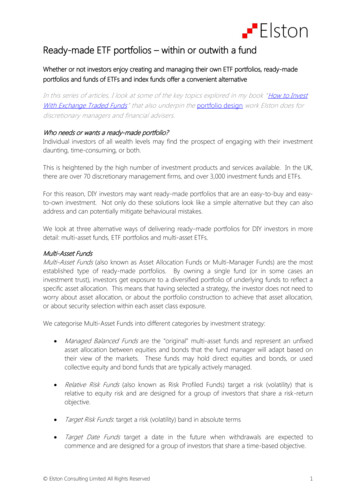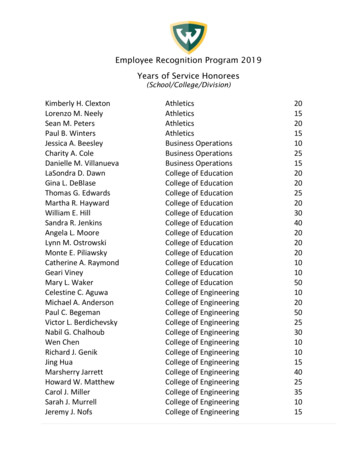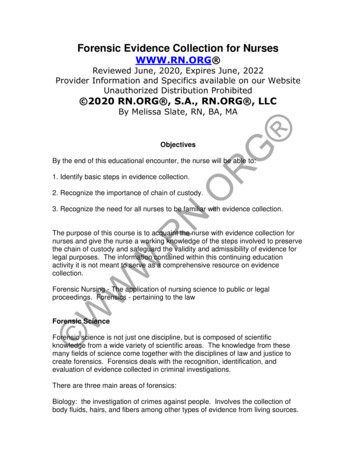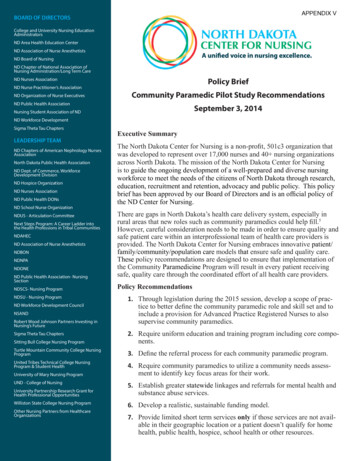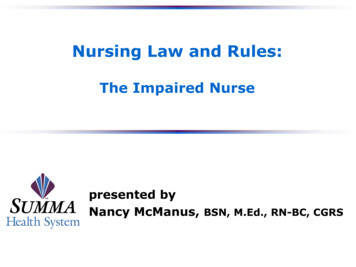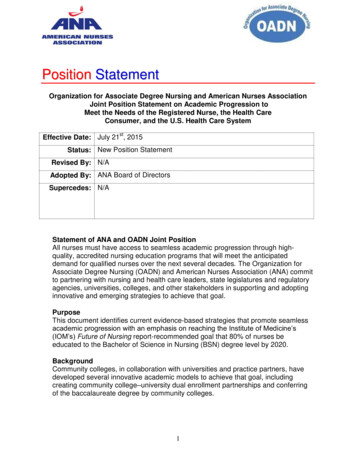
Transcription
Professional DevelopmentLearning ActivityNursingportfolios:a simple guide tocompetency self-assessmentRRRReading the article and completion of this Nursingportfolios: a simple guide to competency selfassessment learning activity is equivalent to60 minutes of professional development.By Liz ManningDeveloping a portfolio andinterpreting the NursingCouncil of New Zealandcompetencies remains aconfusing landscape formany nurses. This articleprovides supportive adviceand examples of howto effectively self-assessnursing practice against thecompetencies, especially fornurses randomly selected fora recertification audit.Learning outcomes Understand rationale for developing anursing portfolio. Know how to approach a self-assessmentagainst the competencies using everydaypractice examples. Increase familiarity with the NursingCouncil of New Zealand website. Locate and review guidelines thatunderpin nursing practice.NCNZ competencies addressedRegistered Nurse competencies 1.1, 2.8, 2.9.Introduction“What is a portfolio? Is it a PDRP? Is it amassive file of information about yourpractice? How do I even begin to selfassess when the competencies aren’tspecific? Anyway, this will take weeks toput together won’t it? I am good at myjob, WHY are you auditing ME?”This article looks at why nurses needto develop a portfolio and offers adviceon how to effectively self-assess nursingpractice against the Nursing Council ofNew Zealand competencies if faced by arecertification audit.There are two circumstances whennurses need to present a portfolio:Being randomly selected for arecertification audit of the continuouscompetence requirements by the NursingCouncil of New Zealand (NCNZ).ORBeing employed by an organisation withan approved Professional Developmentand Recognition Programme (PDRP)8 andbeing required to submit a portfolio ona three-yearly cycle or wishing to applyfor another level of practice. (Nurses ona PDRP should seek specific advice fromtheir PDRP coordinator.)Why portfolios?The Health Practitioners CompetenceAssurance Act (2003)¹ provides aframework for the regulation of healthpractitioners to protect the public wherethere is risk of harm from professionalpractice. The Act identifies responsibleauthorities (e.g. NCNZ) that have therole of ensuring all registered healthpractitioners, issued with an annualpractising certificate (APC), are competentin their scope of practice.The Council has the role of protectingthe public by setting standards andensuring that nurses are competent topractise under the Act. Each year theCouncil randomly selects five per centof practising nurses for a recertificationaudit14.Question: When you receive your APCnotification from NCNZ, do you tick theboxes that declare: you have the required 450 practicehours (over three years)? you have the required 60 professionaldevelopment hours (over three years)? you are competent to practice?Answer: Yes? Then the NCNZrecertification audit is asking you toprovide validated evidence for those ticks.TIPS BOX 1 ONLY include the requested items fromthe checklist. Filling a portfolio does not need to bea linear process. Start with the itemsyou already have. Write about your everyday practice, inyour own words. This isn’t about your best day ever, it’sabout what you do every day.nursingreview.co.nzIssue 2 2017 15
Professional DevelopmentWhat is a portfolio?A portfolio is a standardised way ofstoring information that describes yourcompetence to practice. It’s generally anA4 folder, or an electronic equivalent, withpredefined sections making it easier tocollate and audit.Filling a portfolio for recertificationContentThe NCNZ provide a checklist14 on theirrecertification webpage. Only include theitems requested, keep it simple. Threeforms of verified evidence are required: Record of practice hours. Record of professional developmenthours. Assessment against the competencies Self-assessment Senior nurse or peer reviewCheck the NCNZ website for templates7, 14,15and information. If you cannot meet oneor more of the requirements, contact theNCNZ to explain your situation and theywill advise you what to do.VerificationThe evidence you provide in your portfoliomust be verified, which means signed bysomeone who has either observed yourpractice or can confirm that the evidenceyou have provided is correct and that itis your work. This is often a manager orsenior nurse. They must provide theirname, designation and contact details.CurrencyA portfolio is about your current practice.All the evidence/practice examples youprovide must be from the previous threeyears.PrivacyAny inclusion of third party informationwithout consent is a breach of privacy3, 17.Assessment against the RNcompetenciesWhich competencies?The majority of New Zealand’sapproximately 50,000 registered nursesTIPS BOX 2 Put your practice examples into thedomains then start with the competencyyou think is the easiest to describe. Theindicators may help you decide. Write a statement about your practicethen support it with an objectiveexample (an actual situation thatoccurred). See the examples provided for the RNclinical competencies.16Issue 2 2017nursingreview.co.nzLearning Activity(RNs) are in ‘direct-care’ clinical roles16 andwill complete the RN clinical competencies.However, there are nurses working acrosshealth in myriad different roles whodo not provide direct nursing care butstill influence nursing practice and/orthe nursing workforce. The Council hascreated competencies to recognise andaccommodate the breadth of the scopeand RNs must select a competency set thatreflects their current practice. There arecompetencies for RNs in: clinical⁴ (the majority of RNs) management6/clinical management⁶ education6, policy6, and research6.This article looks at the clinicalcompetencies⁴ in the four domains:Domain 1: Professional responsibility(five competencies)Domain 2: Management of nursing care(nine competencies)Domain 3: Interpersonal relationships(three competencies)Domain 4: Interprofessional healthcareand quality improvement (threecompetencies)Nurses must provide ONE practice examplefor every competency. Each competencyhas ‘indicators’ listed – these are guides tohelp you select your example.The RN domains and competencieswith general examples and tips toguide youDomain 1: Professional responsibilityCompetency 1.1 Accepts responsibilityfor ensuring that his/her nursing practiceand conduct meet the standards of theprofessional, ethical and relevant legislatedrequirements.This covers legislation, acts, ethics,codes, policies and standards that underpinpractice. e.g. Privacy Act, the Code ofRights and workplace health and safetyrequirements. Refer to the NCNZ Code ofConduct⁵ and other guidelines.Competency 1.1Statement about your practice:We had a refresher on the NCNZ Codeof Conduct, social media guidelines andprofessional boundaries last year (see PDhours), which was great, and we keep copiesin the office. I am very aware of the PrivacyAct, the patient’s right to confidentiality andhow that affects who I can talk to about thepatientActual practice example:Last month I was caring for a gentleman whoseneighbour rang to ask for results of a recentblood test; she said she was helping to care forhim and he had asked her to call. I explainedthat I could not discuss the patient’s conditionor blood tests because etc.Competency 1.2 Demonstrates the abilityto apply the principles of the Treaty ofWaitangi/Te Tiriti o Waitangi to nursingpractice.This is specific to Māori, in relation to theTreaty. How do you partner in care? Howdo you protect or advocate? How do youfacilitate patient/whānau participation?10Competency 1.3 Demonstratesaccountability for directing, monitoringand evaluating nursing care that isprovided by enrolled nurses and others.Delegation occurs up, down or sidewayse.g. asking a colleague for help (sideways),escalating a difficult situation to a manager(up), directing a student, healthcareassistant (HCA), or a patient’s family orcarers (down). Refer to the NCNZ Directionand Delegation Guidelines12, 9.Competency 1.4 Promotes anenvironment that enables client safety,independence, quality of life, and health.How do you promote a safe workingenvironment? How do you anticipateand mitigate clinical risk? How do youpromote patient wellbeing and safety e.ghazard identification, reporting incidents,infection control guidelines?Competency 1.5 Practises nursing in amanner that the client determines as beingculturally safe.How do you care for patients who havedifferent cultural¹⁴ requirements from yourown? How do you ascertain their beliefsand how you do respond? How do youknow if the patient determines your care isculturally safe? Think broadly and beyondethnicity. Culture includes many things thatare part of our everyday lives e.g. religion,disability, sexuality, beliefs, food, familyculture and language.Domain 2: Management of nursingcareCompetency 2.1 Provides planned nursingcare to achieve identified outcomes.How do you plan care? Do you use nursingmodels of care? Consider how you plan foran acute episode or a chronic illness, longterm or short term. Who do you involve inthe planning?Competency 2.2 Undertakes acomprehensive and accurate nursingassessment of clients in a variety of settings.How do you conduct your assessments?Do you use an assessment framework e.g.SOAP (subjective, objective, assessment,plan), mini-mental state examination,falls risk, InterRai? This could be initialassessment or assessment following aprocedure, new medication or a regularreassessment. Consider how often youassess; you may have noticed somethingusing your observation skills thatprompted you to undertake a more focusedassessment.
Professional DevelopmentLearning ActivityRecommended resources:The Nursing Council of New ZealandCode of Conduct, guidelines, continuing competency guides,examples and templates plus recertification audit informationavailable at www.nursingcouncil.org.nz/Nurses.The NZNO Guide to Privacy in relation to portfolios etc.Available in the ‘practice’ sectionwww.nzno.org.nz/resources/nzno publications.competency 2.2Statement about your practice:We see walk-in patients and also take phonecalls from patients. We need to be able toquickly assess in a variety of ways.Actual practice example:Walk-in: Last week a new patient presentedwith chest pain. As he came through the doorI saw he was pale and sweaty, rubbing hischest. I immediately used the OLD CARTS chestpain assessment tool etc.Phone call: A young mum rang about her childwho had a fever of 38.8 and had been unwellovernight with an ‘odd’ cough’. I used the TrafficLight System to identify the immediate risks: Iasked for the child’s colour, activity etc.Competency 2.3 Ensures documentationis accurate and maintains confidentiality ofinformation.How do you maintain clear, concise,organised and current documentation?Competency 2.4 Ensures the clienthas adequate explanation of the effects,consequences and alternatives of proposedtreatment options.How do you describe and explain atreatment, medication or a procedure tothe patient? Do you encourage questions?Do they need a support person/interpreter/family member? Do you describe thealternatives and possible outcomes? Do youuse printed information?competency 2.3Statement about your practice:I document as soon as possible after a patientinteraction; I always write things down inaccurate detail as soon as I can with a time,date and signature, and then print my name.competency 2.6Statement about your practice:I regularly meet with patients (and, ifappropriate, their families) to discuss theirrequirements and preferences for their care.Actual practice example:About eight months ago a visitor made acomplaint, claiming I gave their elderly relativethe wrong advice about a medication. Mymanager checked back into the patient’s notesand I had written the conversation down indetail, timed and dated it, with a note that I hadconfirmed everything with the patient etc.Actual practice example:I care for an elderly gentleman who is nowunable to attend appointments for wound carebecause of chronic pain, transport issues andliving alone. I recently organised to meet withhim to review the options for his situation sohe could get the care he needed in a waywhich met his planned care needs and hispreferences starting with etc.Competency 2.5 Acts appropriatelyto protect oneself and others whenfaced with unexpected client responses,confrontation, personal threat or othercrisis situations.What systems does your workplace havefor crisis situations and what is your rolein managing these? For example, cardiacarrest, security threat, anaphylaxis andother significant events.Competency 2.6 Evaluates client’sprogress toward expected outcomes inpartnership with clients.How do you assess if your care is safeand effective? How have you involvedpatients in care planning? How do youcontribute to discussions and planning forthe patients?Competency 2.7 Provides healtheducation appropriate to the needs of theclient within a nursing framework.Why is health education important andhow do you ensure you are offering it ina timely, consistent and appropriate way?Do you use printed resources or websites?Is it age and ability appropriate e.g. quitsmoking, green prescription or a newmedication? It could be to a patient, familyor caregivers. How do you evaluate theeffectiveness of your education?Competency 2.8 Reflects upon, andevaluates with peers and experiencednurses, the effectiveness of nursing care.How do you support your colleaguesand peers to reflect on their practice?Does your employer have a system fornursingreview.co.nzIssue 2 2017 17
Professional Developmentseeking advice or debriefing? Have youmade changes to patient care followingreflection or professional discussion? Doyou attend professional supervision?Competency 2.9 Maintains professionaldevelopment (PD).You should include your PD record,but you can always add a reflection on aspecific PD activity and how it affectedyour practice.Domain 3: InterpersonalrelationshipsCompetency 3.1 Establishes, maintainsand concludes therapeutic interpersonalrelationships with client.It’s all about communication. Howdo you approach people every day; newpatients or patients you have known fora long time? How do you form trustingrelationships quickly and how do youmaintain your longer term professionalrelationship with patients? How do youdemonstrate knowledge of verbal andnonverbal skills (body language) in yourcommunication with patients?Competency 3.2 Practises nursing ina negotiated partnership with the clientwhere and when possible.Consider the patient’s right to refusetreatment – do you practice informedconsent? How will the planned care workfor the patient e.g. can they get to anappointment? What do you discuss withthe patient to get the care they need in theright way, at the right time and place?Competency 3.3 Communicateseffectively with clients and members of thehealth care team.Consider the many techniques you useto communicate with patients and to theteam. How do you know they are effective?Learning ActivityCompetency 3.3Statement about your practice:I think communication and listening is key togood practice. I always assess carefully whenI meet patients to find out how they need tocommunicate and what works best for them.Actual practice example:Recently a new resident, an elderly gentlemanwho is profoundly deaf, had staff shoutinginstructions to him. I felt this undermined hisdignity and was ineffective. I introduced myselfto him and asked if I could sit next to him. Iasked him if I could use a pen and paper toget my messages across in writing which hereally liked etc.Domain 4: Interprofessionalhealthcare and qualityimprovementCompetency 4.1 Collaborates andparticipates with colleagues and membersof the healthcare team to facilitate andcoordinate care.This is about the wider team,sometimes outside your ownorganisation. How do you work withother providers? How do you approachhandover, multi-disciplinary meetingsor case reviews? How do you organise areferral e.g. to a dietician or podiatrist,or discuss and plan care with othermembers of the healthcare team?Competency 4.2 Recognises and valuesthe roles and skills of all members of thehealthcare team in the delivery of care.Do you recognise when different skillsare needed e.g. a physiotherapist, asocial worker, a doctor? How do roles andclinical skills differ? How do you recogniseand coordinate this e.g. in a dischargeplan, patient deterioration, coordinationof a procedure or appointment?Competency 4.3 Participates in qualityimprovement activities to monitor andimprove standards of nursing.This could be participation in a clinicalaudit, survey, or nursing care qualityinitiative e.g. procedure technique, wounddressing, medication administration,documentation or communicationprocess. Hazards, unsafe equipment orincident reporting. Focus on nursingpractice.In conclusion, a portfolio does not needto be confusing. Just step back, reflect onyour practice and start recording yourexamples, competency by competency.About the author:Liz Manning, RN, BN, MPhil (Nursing),FCNA(NZ) is a director of KynanceConsulting and is a nurse consultantwho has worked in the area of portfolios,assessment, auditing and PDRP for manyyears.This article was peer reviewed by:Linda Adams RN PG Cert HSc is a qualityadvisor for MedScreen. She is a formerPDRP nurse advisor, recertification andPDRP auditor and competence assessor forNCNZ.Lorraine Hetaraka-Stevens RN PG Dip(nursing), MNurs (in progress) is anexperienced competence assessor andnurse leader who is currently nurse leaderof the National Hauora Coalition.ReferencesCompetence Assessment Form for RegisteredGuidelines: Professional Boundaries. Wellington:ASSURANCE ACT (2003). Retrieved December 2016Nurses Practising in Policy.Author.from www.legislation.govt.nz/act/public/2003.Competence Assessment Form for Registered1. HEALTH PRACTITIONERS COMPETENCE2. MANNING L (2015). Tips for a top nurse portfolio.Nursing Review 15(2) 28.3. NEW ZEALAND NURSES ORGANISATION (2016).7. NURSING COUNCIL OF NEW ZEALAND (2014).Examples for self-assessment and senior nurseGuideline: Privacy, Confidentiality and Consent inassessment for the registered nurse scope ofthe Use of Exemplars of Practice, Case Studies, andpractice.Journaling, 2016.8. NURSING COUNCIL OF NEW ZEALAND (2013).4. NURSING COUNCIL OF NEW ZEALAND (2007).Framework for the approval of professionalCompetencies for Registered Nurses. Wellington:development and recognition programmes toAuthor.meet the continuing competence requirements for5. NURSING COUNCIL OF NEW ZEALAND (2012).Code of Conduct. Wellington: Author.6. NURSING COUNCIL OF NEW ZEALAND (2011).Competence Assessment Form for RegisteredNurses in Clinical Management.nurses. Wellington: Author.9. NURSING COUNCIL OF NEW ZEALAND (2011).Guideline: Direction and Delegation of Care by aRegistered Nurse to a Health Care Assistant.10. NURSING COUNCIL OF NEW ZEALAND (2011).Competence Assessment Form for RegisteredGuidelines for Cultural Safety, the Treaty ofNurses Practising in Education.Waitangi and Māori Health in Nursing EducationCompetence Assessment Form for RegisteredNurses Practising in Management.18Nurses Practising in Research.Issue 2 2017nursingreview.co.nzand Practice. Wellington: Author.11. NURSING COUNCIL OF NEW ZEALAND (2012).12. NURSING COUNCIL OF NEW ZEALAND (2011).Guideline: Responsibilities for Direction andDelegation of Care to Enrolled Nurses.13. NURSING COUNCIL OF NEW ZEALAND(2012). Guidelines: Social Media and ElectronicCommunication. Wellington: Author.14. NURSING COUNCIL OF NEW ZEALANDRecertification Audits & Recertification AuditChecklist.15. NURSING COUNCIL OF NEW ZEALAND (2011).Template for Evidence of Professional DevelopmentHours.16. NURSING COUNCIL OF NEW ZEALAND (2015).The New Zealand Nursing Workforce: A Profile ofNurse Practitioners, Registered Nurses and EnrolledNurses 2014–15. Wellington: Author.17. PRIVACY ACT (1993). Retrieved December 2016 atest/DLM296639.html.
Professional DevelopmentLearning ActivityProfessionalDevelopmentLearning ActivityLearning outcomes Understand rationale for developing anursing portfolio. Know how to approach a self-assessmentagainst the competencies using everydaypractice examples. Increase familiarity with the NursingCouncil of New Zealand website. Locate and review guidelines thatunderpin nursing practice.NCNZ competencies addressedRegistered Nurse competencies 1.1, 2.8, 2.9.Reading the article and completion of this Nursing portfolios: a simple guideto competency self-assessment learning activity is equivalent to 60 minutes ofprofessional development.This learning activity is relevant to the NZNC RN competencies 1.1, 2.8, 2.9.Please discuss all your answers with your peer/s.AReading1Select and read the NCNZ guidelines that you are least familiar with i.e. Code of Conduct⁵, Professional Boundaries11 or SocialMedia13 www.nursingcouncil.org.nz/Nurses.2Further suggested reading: ‘Tips for a top nursing portfolio’² tips-for-a-top-nurse-portfolio/#.WC5bYuZ95PY NZNO privacy guidelines in relation to portfolios, case studies and exemplars ion1Reflect on your routine practice. Think about how you approach patients, how you develop trusting relationships, and howyou routinely plan, deliver and coordinate care with health professional teams.2Choose a relatively common occurrence in your everyday practice. Think back to the most recent example of how you dealtwith this. Review and reflect on what went well, what was the outcome and what, if anything, you would do differently nexttime.CReality1Identify and write down FOUR examples of your own practice (refer to exemplar examples in article). Identify which domainand then which competency they apply to.2Discuss with a colleague how you would approach their peer assessment; what specific examples of their practice you woulduse and to which competencies did they apply?Verification by a colleague of your completion of this activityColleague nameDesignationDateNursing council IDWork addressContact #nursingreview.co.nzIssue 2 2017 19
nursing portfolio. Know how to approach a self-assessment against the competencies using everyday practice examples. Increase familiarity with the Nursing Council of New Zealand website. Locate and review guidelines that underpin nursing practice. NCNZ competencies addressed Registered Nurse competencies 1.1, 2.8, 2.9. TIPS BOX 1

